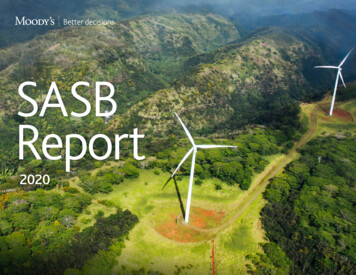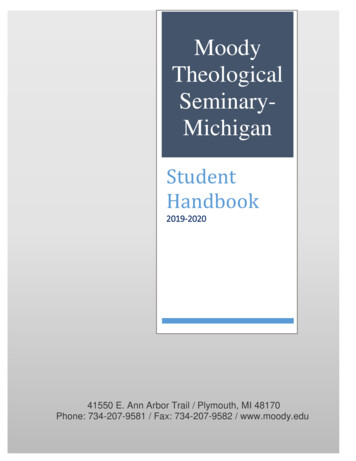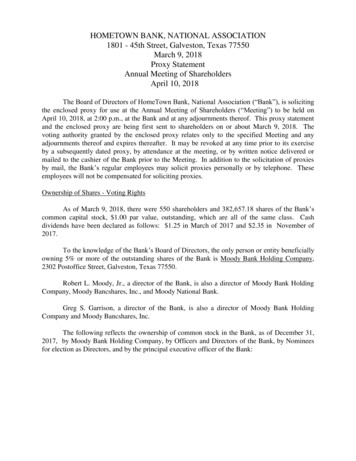
Transcription
SASBReport2020
Moody’s SASB Report 20202We have participated in the XBRL tagging pilot program in an effort to help advance more standards-based and comparable disclosure. Because the taxonomy forthe tags is still being developed, not all are specifically applicable to our disclosure. We have made an effort to find applicable tags in order to make our informationas comparable to others as possible. In addition, historical, current, and forward-looking sustainability-related statements may be based on standards formeasuring progress that are still developing, internal controls and processes that continue to evolve, and assumptions that are subject to change in the future.VIEW XBRL VERSION »Moody’s SASB Report 2020The Sustainability Accounting Standards Board (SASB) connects businesses and investors to the financial impacts ofsustainability. Moody’s reports in accordance with the SASB Standard for Professional & Commercial Servicesindustry. Moody’s will continue to examine ways to adjust its disclosures as these topics change over time.Unless otherwise noted, this document covers all of Moody’s Corporation (NYSE: MCO) and its subsidiaries, and all quantitative data covers the period from January 1 to December 31, 2020.CONTENTSSustainability Disclosure Topics and Accounting MetricsActivity MetricsNumber of employees by:(1) full time and part time, (2) temporary and (3) contractSUSTAINABILITY DISCLOSURE TOPICS AND ACCOUNTING METRICSTopicData securityAccounting MetricCategoryCodeMoody’s ResponseDescription of approach toidentifying and addressingdata security risks iscussion andDanalysisSV-PS-230a.1Moody’s protects the data and security of its stakeholders, investing in world-class IT systems and infrastructure. Moody’semployees uphold its security-first philosophy, and the Company holds its third-party partners to this same standard.Moody’s is committed to developing and maintaining a best-in-class information security program that addresses, among otherareas, privacy and data security, including of its customers’ data. Moody’s program integrates the Company’s business objectiveswith industry and internal best practices to provide a foundation for decision-making regarding the management, security anduse of data within the organization. All employees receive global privacy and information security training at onboarding andperiodically thereafter. Data is safeguarded based on requirements and controls determined by Moody’s Information Risk andSecurity, which include access and right-of-use controls. Security controls are periodically evaluated by Internal Audit.The global pandemic and remote work raised new threats in cybersecurity and the growing intersection of supply chains,connectivity and access to data is increasing the potential for cyber attacks. As a result, Moody’s built on its existing disasterpreparedness capabilities for working from home with enhanced training on new methods for cyber-attack management. TheCompany continued to monitor and strengthen its IT infrastructure and partner with leading organizations to share cuttingedge security solutions.Security managementMoody’s combines expertise and technological innovation to outpace emerging threats. The Company’s employees takecybersecurity training to better recognize and respond to potential threats, including attack and phishing simulation exercisesseveral times a year. Moody’s provides training portals on emerging cyber threats that help educate software-developmentteams on secure coding practices.Data privacyMoody’s policies comply with the data privacy laws in the jurisdictions in which it operates. Moody’s Privacy Policy explains howthe Company collects personal information, how it uses, discloses and protects such information, and the choices its customershave concerning use of such data.Reasonable organizational and technical measures were implemented to protect personal information within Moody’sorganization, and the Company’s employees are required to take privacy and information security training that coversthese concepts.
Moody’s SASB Report 20203TopicAccounting MetricCategoryCodeMoody’s ResponseDescription of approach toidentifying and addressingdata security risks(continued) iscussion andDanalysisSV-PS-230a.1Moody’s meets data governance obligations through:» a dedicated and specialist Privacy team, internal data privacy policies and procedures, and a dedicated data subject rightsprocess;» enterprise-wide data privacy training for all employees at onboarding and periodically thereafter, and awareness andadditional role-based training and guidance for teams handling personal data;» Information Risk & Security teams, policies and procedures, including cybersecurity, incident management response andvendor cybersecurity;» an Incident Response Management Plan involving all relevant departments; and» a requirement that key vendors complete security assessments and execute appropriate terms to their vendor agreementsif they are to process personal data controlled by Moody’s.Technology risks for the Company and how they are addressed are disclosed in Item 1A – Risk Factors ofMoody’s 2020 Form 10-K on pages 38–39.For more information, see Moody’s 2020 Stakeholder Sustainability Report, Data privacy, page 10.Description of policiesand practices relating tocollection, usage, andretention of customerinformationDiscussion andanalysisSV-PS-230a.2Moody’s policies comply with the data privacy laws in the jurisdictions in which the Company operates. Moody’s PrivacyPolicy explains how the Company collects personal information, how it uses, discloses and protects such information, andthe choices its customers have concerning use of such data.Reasonable organizational and technical measures were implemented to protect personal information within Moody’sorganization, and the Company’s employees are required to take privacy and information security training that coversthese concepts.Data securityMoody’s privacy notices are publicly available online s://www.csi.ca/student/en /cookies-noticehttps://www.csi.ca/student/en yQuantitative(1) Number of databreaches, (2) percentageinvolving customers;confidential businessinformation (CBI) orpersonally identifiableinformation (PII), (3) numberof customers affected.SV-PS-230a.3Moody’s does not disclose specific information in this area due to confidentiality constraints. Please see Moody’s PrivacyPolicy to learn more about its approach to customer privacy.
Moody’s SASB Report 20204TopicAccounting MetricCategoryCodeMoody’s ResponsePercentage of genderand racial/ethnic grouprepresentation for(1) executive managementand (2) all other employeesQuantitativeSV-PS-330a.1Gender statistics: global workforce1201820192020Employee 2NotFemaledisclosed33%MaleNotdisclosed67%0%Senior managers33%67%33%67%33%67%0%Mid-level managers32%68%33%67%33%67%0%First-level 2%48%51%1%41%58%41%58%1%Total1%Race and ethnicity statistics: United States1Workforcediversity andengagement20192020White49%49%Underrepresented groups346%46%Not disclosed5%5%Race and ethnicity statistics: United States officers and managers42020WhiteUnderrepresented groupsNot disclosed53%343%4%1 T he data represents employees that are integrated in Moody’s IT systems. For 2020, this coverage is approximately 85% of the total Moody’s full-timeequivalent employees as reported in the 2020 Form 10-K. Non-employees (such as non-payroll consultants) and temporary employment workers (such asinterns) are excluded from the analysis. Headcount as of December 31 of respective year.2 E xecutives represent managing directors, executive directors and CEO direct reports; senior managers represent senior vice presidents and senior directors;mid-level managers represent vice presidents and directors; first-level managers represent assistant vice presidents and associate directors; non-managersrepresent managers, associates and analysts.3 U nderrepresented groups include those who identified as Asian, Hispanic, Black, Native American/Alaskan Native, Hawaiian/Other Pacific Island or two ormore races.4 Officers and managers are calculated using the job categories: executives, senior managers, mid-level managers and first-level managers. The data is based onCompany records and may involve estimates or assumptions.Moody’s is an equal opportunity employer and does not make employment decisions on the basis of race, ethnicity, gender or any other protected characteristic.Moody’s recognizes that many different factors – for example, business growth and related new openings, successful recruitment of diverse applicants, and turnover– will play key roles in whether or not the Company achieves its goals. Where it is within its control, the Company is focusing on each of these factors to create a robustdiversity, equity and inclusion strategy that reflects its desire to be a market leader in this space.
Moody’s SASB Report 20205TopicAccounting MetricCategoryCodeMoody’s Response(1) Voluntary and (2)involuntary turnover ratefor employeesQuantitativeSV-PS-330a.2Employee turnover rate120192020Voluntary turnover12%7%Involuntary turnover3%4%The decline in the Company’s voluntary turnover rates in 2020 compared to 2019 is likely due to the effects of COVID-19 onthe labor market.Workforcediversity andengagement1 The data represents employees that are integrated in our IT systems. For 2020, this coverage is approximately 85% of the total Moody’s full-time equivalentemployees as reported in the 2020 Form 10-K. Non-employees (such as nonpayroll consultants) and temporary employment workers (such as interns) areexcluded from the analysis. Headcount as of December 31 of respective year.Employee engagement asa percentageQuantitativeSV-PS-330a.3Employee engagement score2Employees participating in employeeengagement surveys20192020717687%86%The 2020 global benchmark is 74.32 Moody’s engagement score consists of an average of two questions: “How happy are you at Moody’s?” and” Would you recommend Moody’s?”.3 G lint’s global benchmark definition: “Cross-client, cross-industry and cross-country, Glint’s global benchmark represents companies that have a home base invarious countries and may or may not operate outside of their home country. Combining panel and employee data, our benchmarks include employees fromwell over 500 companies that have greater than 5,000 employees each, of which over 50 companies have over 100,000 employees each. Respondents areincluded from over 150 countries. Given our unique approach, our benchmarks represent tens of millions of employees.”
Moody’s SASB Report 20206TopicAccounting MetricCategoryCodeMoody’s ResponseDescription of approachto ensuring professionalintegrityDiscussion andanalysisSV-PS-510a.1Every Moody’s employee, as well as each member of the Board of Directors, is required to abide by Moody’s Code of BusinessConduct, which outlines the principles and policies they are expected to follow in their daily business activities. The Legaldepartment is responsible for updates and distribution of the Code. HR is responsible for distribution of the Code to newemployees.The Code, which is revised and republished at least every two years, is available in 11 languages: Arabic, Chinese, Dutch, English,French, Japanese, Korean, Portuguese, Russian, Slovak and Spanish. Upon hiring and periodically thereafter, including when a newversion is published, all employees must certify that they have read, understand and will adhere to the Code. View Moody’s Codeof Business Conduct and other corporate governance documents: bit.ly/moodyscgsp.In addition to the Code of Business Conduct, Moody’s Investors Service has a Code of Professional Conduct that governs the creditrating process.Moody’s has implemented a Supplier Code of Conduct describing its expectations of incumbent and prospective vendors in theareas of business integrity, labor practices, employee health and safety, diversity and inclusion, and environmental stewardship.In 2020, Moody’s published its Human Rights Statement, which provides an overview of how Moody’s endeavors to meet itsresponsibility to respect human rights.Moody’s is committed to fostering a culture and work environment in which all employees feel comfortable asking questions,seeking advice and raising issues that are important to them, including reporting allegations of non-compliance with laws,regulations and policies. The Company elevates voices and concerns through its Open Door Policy, which supports employees inholding frank discussions with their immediate supervisors or other senior managers, as well as with members of the Compliance,HR and Legal departments. As part of this policy, Moody’s prohibits, and does not tolerate, any form of retaliation againstemployees who raise concerns in good faith.ProfessionalintegrityAll employees have a number of channels to report concerns: managers; HR, Compliance and Legal departments; and the IntegrityHotline. The Integrity Hotline allows employees to report any suspected wrongdoing anonymously, is staffed by a third partyand is available at all times and in multiple languages. Reports made via the Integrity Hotline are forwarded to Moody’s Legal andCompliance departments for follow-up, and all reports of suspected violations are promptly investigated and remediated.Finally, Moody’s provides extensive compliance and ethics training both to new employees and to existing employees to helpreinforce the resources available to them to raise concerns and ask questions and as an integral part of their overall professionaldevelopment. Depending on the line of business and work location, within their first 90 days of employment, new hires to Moody’smust complete between five and eight-and-a-half hours of online training that is aligned with Moody’s codes of conduct andpolicies. This training is designed to help Moody’s employees clearly understand and execute their ethical responsibilities andregulatory obligations.Learn more about Moody’s mechanisms for reporting concerns and receiving advice about potential policy violations or ethicalissues in its Code of Business Conduct (pages 11–13).In 2020, Moody’s deployed or conducted over 35 mandatory online and instructor-led courses to educate and refresh theknowledge of existing employees on compliance policies and codes of conduct.Total amount of monetarylosses as a result of legalproceedings associated withprofessional integrityQuantitativeSV-PS-510a.2 Material legal proceedings for the Company are disclosed in Note 21, Contingencies, on page 127 of Moody’s 2020 Form 10-K.
7Moody’s SASB Report 2020Activity MetricCategoryCodeMoody’s ResponseNumber of employees by:QuantitativeSV-PS-000.AAs of December 31, 2020, the number of Moody’s full-time equivalent employees was 11,490. The majority of Moody’semployees are employed on full-time contracts. A proportion of the Company’s employees are part time, and their termsand conditions are otherwise the same as for full-time staff. Moody’s may engage temporary employees, contractors andconsultants for a variety of business purposes. There are no significant variations in Moody’s employment numbers duringthe year (such as seasonal variations).(1) full time and part time, (2) temporary,and (3) contractGlobal employee breakdown by gender120192020Male58%58%Female41%41%Not disclosed1%1%20192020Americas (excluding .3,9094,225Global employee breakdown by region2For additional information on Moody’s workforce, see Moody’s 2020 Stakeholder Sustainability Metric Summary, page 3.1 T he data represents employees that are integrated in Moody’s IT systems. For 2020, this coverage is approximately 85% of the total Moody’s full-timeequivalent employees as reported in the 2020 Form 10-K. Non-employees (such as non-payroll consultants) and temporary employment workers (such asinterns) are excluded from the analysis. Headcount as of December 31 of respective year.2 T he data represents the total Moody’s full-time equivalent employees as reported in the 2020 Form 10-K. Headcount as of December 31 of respective year.Questions? sustainability@moodys.com
1 The data represents employees that are integrated in Moody's IT systems. For 2020, this coverage is approximately 85% of the total Moody's full-time equivalent employees as reported in the 2020 Form 10-K . Non-employees (such as non-payroll consultants) and temporary employment workers (such as interns) are excluded from the analysis.










